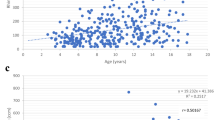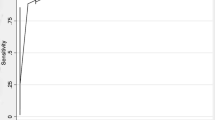Abstract
Objective
Adenoid hypertrophy may coexist, and often does, with rhinitis. Therefore, in some cases, adenoidectomy alone, despite the fact that it reduces nasal resistance, may be insufficient to restore nasal breathing. Juliusson et al. suggested using rhinomanometry with and without nasal decongestant as a method for selecting patients for adenoidectomy. In this study, we aim to assess whether the decongestant test, when using normative data, is useful to select children for adenoidectomy.
Methods
Children between 4 and 15 years old undergoing adenoidectomy were selected from two tertiary referral university hospitals. Participants underwent anterior active rhinomanometry with and without nasal decongestant before and after surgery. Parents fill in the sinus and nasal quality-of-life survey (SN5).
Results
47 participants were included, and mean age 6.5 ± 2.15. 2 cohorts were defined according to the result of the nasal decongestant test (> 40% improvement in nasal resistance or not). There is a statistically significant difference between groups, with a higher improvement in nasal resistance and airflow after adenoidectomy in the group with less than 40% improvement in nasal resistance.
Conclusions
In conclusion, this study supports the use of the decongestant test with rhinomanometry to select children for adenoidectomy; especially as it has proven to be a simple technique, harmless, fast, and easily performed on collaborative children.



Similar content being viewed by others
References
Isaac A, Major M, Witmans M, Alrajhi Y, Flores-Mir C, Major P et al (2015) Correlations between acoustic rhinometry, subjective symptoms, and endoscopic findings in symptomatic children with nasal obstruction. JAMA Otolaryngol Head Neck Surg 141(6):550–555
Cassano P, Gelardi M, Cassano M, Fiorella ML, Fiorella R (2003) Adenoid tissue rhinopharyngeal obstruction grading based on fiberendoscopic findings: a novel approach to therapeutic management. Int J Pediatr Otorhinolaryngol 67(12):1303–1309
Calvo-Henriquez C, Branco AM, Lechien JR, Sandoval-Pacheco V, Maldonado-Alvarado B, Maza-Solano J et al (2021) Assessing the effect of adenoidectomy on nasal resistance and airflow. A systematic review and meta-analysis. Int J Pediatr Otorhinolaryngol 151:110969
Juliusson S, Bende M (1987) Rhinomanometry at selection for adenoidectomy. Rhinology 25(1):63–67
Zicari AM, Magliulo G, Rugiano A, Ragusa G, Celani C, Carbone MP et al (2012) The role of rhinomanometry after nasal decongestant test in the assessment of adenoid hypertrophy in children. Int J Pediatr Otorhinolaryngol 76(3):352–356
Calvo-Henriquez C, Mayo-Yáñez M, Lechien JR, Moure JD, Faraldo-García A, Martinez-Capoccioni G et al (2021) Looking for a cutoff value for the decongestant test in children suffering with turbinate hypertrophy. Eur Arch Otorhinolaryngol 278:3821–3826
Cervera Escario J, Del Castillo MF, Gómez Campderá JA, Gras Albert JR, Pérez Piñero B, VillafruelaSanz MA (2006) Indicaciones de adenoidectomía y amigdalectomía: documento de Consenso entre la Sociedad Española de Otorrinolaringología y Patología Cervicofacial y la Asociación Española de Pediatría. Acta Otorrinolaringol Esp 57(2):59–65
Clement PR, Gordts F (2005) Standardisation Committee on Objective Assessment of the Nasal Airway, IRS, and ERS. Consensus report on acoustic rhinometry and rhinomanometry. Rhinology 43(3):169–179
Calvo-Henríquez C, Valencia-Blanco B, Boronat-Catalá B, Maza-Solano J, Díaz-Anadón Á, Kahn S et al (2020) Cross-cultural adaptation of the sinus and nasal quality of life survey (SN-5) to Spanish. Int J Pediatr Otorhinolaryngol 139:110425
Kay DJ, Rosenfeld RM (2003) Quality of life for children with persistent sinonasal symptoms. Otolaryngol Head Neck Surg 128(1):17–26
Kindermann CA, Roithmann R, Lubianca Neto JF (2008) Sensitivity and specificity of nasal flexible fiberoptic endoscopy in the diagnosis of adenoid hypertrophy in children. Int J Pediatr Otorhinolaryngol 72(1):63–67
Camacho M, Zaghi S, Certal V, Abdullatif J, Means C, Acevedo J et al (2015) Inferior turbinate classification system, grades 1 to 4: development and validation study. Laryngoscope 125(2):296–302
Calvo-Henriquez C, Branco AM, Lechien JR, Maria-Saibene A, DeMarchi MV, Valencia-Blanco B et al (2021) What is the relationship between the size of the adenoids and nasal obstruction A systematic review. Int J Pediatr Otorhinolaryngol 151:110895
Occasi F, Duse M, Vittori T, Rugiano A, Tancredi G, De Castro G et al (2016) Primary school children often underestimate their nasal obstruction. Rhinology 54(2):164–169
Jiang ZY, Pereira KD, Friedman NR, Mitchell RB (2012) Inferior turbinate surgery in children: a survey of practice patterns. Laryngoscope 122(7):1620–1623
Dinis PB, Haider H, Gomes A (1999) The effects of adenoid hypertrophy and subsequent adenoidectomy on pediatric nasal airway resistance. Am J Rhinol 13(5):363–369
Kim YK, Kang JH, Yoon KS (1998) Acoustic rhinometric evaluation of nasal cavity and nasopharynx after adenoidectomy and tonsillectomy. Int J Pediatr Otorhinolaryngol 44(3):215–220
Calvo-Henriquez C, Capasso R, Martínez-Capoccioni G, Rangel-Chaves J, Liu SY, O’Connor-Reina C et al (2020) Safeness, subjective and objective changes after turbinate surgery in pediatric patients: a systematic review. Int J Pediatr Otorhinolaryngol 135:110128
Ta NH, Gao J, Philpott C (2021) A systematic review to examine the relationship between objective and patient-reported outcome measures in sinonasal disorders: recommendations for use in research and clinical practice. Int Forum Allergy Rhinol 11(5):910–923
Saito K, Ono T, Mochida M, Ohyama K (2006) Changes in nasorespiratory function in association with maxillary distraction osteogenesis in subjects with cleft lip and palate. Cleft Palate Craniofac J 43(1):75–83
Lee CH, Hsu WC, Ko JY, Yeh TH, Lin MT, Kang KT (2019) Revision adenoidectomy in children: a meta-analysis. Rhinology 57(6):411–419
Huang SW, Giannoni C (2001) The risk of adenoid hypertrophy in children with allergic rhinitis. Ann Allergy Asthma Immunol 87(4):350–355
Parker AJ, Maw AR, Powell JE (1989) Rhinomanometry in the selection for adenoidectomy and its relation to preoperative radiology. Int J Pediatr Otorhinolaryngol 17(2):155–161
Jones AS, Lancer JM, Stevens JC, Beckingham E (1987) Rhinomanometry: do the anterior and posterior methods give equivalent results? Clin Otolaryngol Allied Sci 12(2):109–114
Kobayashi R, Miyazaki S, Karaki M, Kobayashi E, Karaki R, Akiyama K et al (2011) Measurement of nasal resistance by rhinomanometry in 892 Japanese elementary school children. Auris Nasus Larynx 38(1):73–76
Fielder CP (1985) The effect of adenoidectomy on nasal resistance to airflow. Acta Otolaryngol 100(5–6):444–449
Ciprandi G, Cirillo I, Klersy C, Castellazzi AM, Barberi S, Marseglia GL (2007) Nasal decongestion test in allergic rhinitis: definition of responder. Int Immunopharmacol 7(3):372–374
Principato JJ, Wolf P (1985) Pediatric nasal resistance. Laryngoscope 95(9 Pt 1):1067–1069
Funding
There is no financial support.
Author information
Authors and Affiliations
Corresponding author
Ethics declarations
Conflict of interest
This work is part of the research completed by Christian Calvo-Henriquez, MD, to obtain a PhD degree. The rest of authors declare no disclosure or conflict of interest.
Ethical approval
All procedures performed in studies involving human participants were in accordance with the ethical standards of the institutional and/or national research committee and with the 1964 Helsinki Declaration and its later amendments or comparable ethical standards.
Additional information
Publisher's Note
Springer Nature remains neutral with regard to jurisdictional claims in published maps and institutional affiliations.
Rights and permissions
About this article
Cite this article
Calvo-Henriquez, C., Rivero, I., Maldonado-Alvarado, B. et al. Rhinomanometry with and without decongestant used to select children for adenoidectomy: a cohort study. Eur Arch Otorhinolaryngol 280, 723–729 (2023). https://doi.org/10.1007/s00405-022-07549-7
Received:
Accepted:
Published:
Issue Date:
DOI: https://doi.org/10.1007/s00405-022-07549-7




